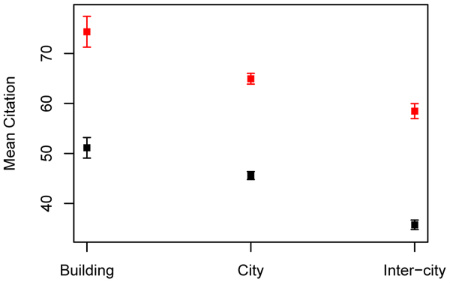
« PREVIOUS ENTRY
The end of the office

When I wrote about “the death of the office,” I heard a lot of young entrepreneurs say they collaborate very successfully online, often with colleagues and employees who are in different cities or countries. As it turns out, the academic world has seen a similar shift — an explosion of collaboration amongst scientists, with virtual teams forming across date lines. Some scientists make an argument similar to the officeless entrepreneurs: Because Skype and email and wikis and instant messaging make it so easy to collaborate remotely, they can now pick the most talented colleagues to work with irrespective of geographic location. Teams rock harder because you’re no longer stuck, spatially, with the dude down the hallway who’s been on tenure autopilot for two decades. All told, a victory for the intertubes, no?
Ah, but now comes a fascinating study by three scientists at Harvard: “Does Collocation Inform the Impact of Collaboration?” They wondered whether teams that are located in the same place produce papers that have a bigger impact than teams who are disparate. So they gathered info on 35,000 papers in biomedical research where there was at least one Harvard author, calculated where the authors lived, and examined how influential the papers were — based on how many citations they received.
The upshot? Being physically close together is better. Teams that worked in the same place produced papers with a bigger impact than those who lived further apart. This was particularly true when you measure the physical distance between the first and last author of a paper. Check out the scatter plot above: It shows that teams located in the same building did better than teams that were merely in the same city, and teams that were in the same city did better than those that were inter-city.
Why would this be? As the researchers suggest:
There are a number of possible explanations for these associations. It may be that physical proximity truly allows for better collaboration, resulting in higher quality research that tends to be cited more often. It may also be that investigators have a strategic preference for keeping potentially high impact projects wholly within their own laboratory or close circle of research associates.
As they also point out, it’s hard to read too much into these findings. These results may be a quirk of the biomedical sciences, or a result of departmental structure specific to Harvard.
But my guess it that there’s something here. Even in my “end of the office” piece I report on entpreneurs who found that certain types of work are really hard — or perhaps impossible — to do well remotely. One example is doing a big huge rethink of a major part of your business: Several folks told me that if they wanted to tear down a central database and rebuild it, you need everyone in a room together. I know people who’ve redesigned magazines, a task that would have been unfathomable if everyone weren’t in the same conference room. As the science on virtual collaboration emerges, we may find some commonalities between types of work that are best done face to face, and those that work well remotely.
Then again, there may be surprises. I was recently reading The Medici Effect — which is about how to foster creativity — and was surprised to discover that most brainstorming is probably conducted in the wrong way. Generally, people think of “brainstorming” as gathering everyone in a room so they can yell out ideas, with one person writing down the ideas on a whiteboard. But studies show that can shut people down: They get nervous about speaking out loud, or they think their idea isn’t interesting, or one person dominates the brainstorming and drags the center of gravity, for good or ill, in one direction. In contrast, a 1958 study found that if you take the members of your team, put them in different rooms, and ask each to brainstorm solutions to a problem, they’ll produce more and better ideas. That’s because the problems of face-to-face dynamics go away: The “virtual” group is better.
I'm Clive Thompson, the author of Smarter Than You Think: How Technology is Changing Our Minds for the Better (Penguin Press). You can order the book now at Amazon, Barnes and Noble, Powells, Indiebound, or through your local bookstore! I'm also a contributing writer for the New York Times Magazine and a columnist for Wired magazine. Email is here or ping me via the antiquated form of AOL IM (pomeranian99).

ECHO
Erik Weissengruber
Vespaboy
Terri Senft
Tom Igoe
El Rey Del Art
Morgan Noel
Maura Johnston
Cori Eckert
Heather Gold
Andrew Hearst
Chris Allbritton
Bret Dawson
Michele Tepper
Sharyn November
Gail Jaitin
Barnaby Marshall
Frankly, I'd Rather Not
The Shifted Librarian
Ryan Bigge
Nick Denton
Howard Sherman's Nuggets
Serial Deviant
Ellen McDermott
Jeff Liu
Marc Kelsey
Chris Shieh
Iron Monkey
Diversions
Rob Toole
Donut Rock City
Ross Judson
Idle Words
J-Walk Blog
The Antic Muse
Tribblescape
Little Things
Jeff Heer
Abstract Dynamics
Snark Market
Plastic Bag
Sensory Impact
Incoming Signals
MemeFirst
MemoryCard
Majikthise
Ludonauts
Boing Boing
Slashdot
Atrios
Smart Mobs
Plastic
Ludology.org
The Feature
Gizmodo
game girl
Mindjack
Techdirt Wireless News
Corante Gaming blog
Corante Social Software blog
ECHO
SciTech Daily
Arts and Letters Daily
Textually.org
BlogPulse
Robots.net
Alan Reiter's Wireless Data Weblog
Brad DeLong
Viral Marketing Blog
Gameblogs
Slashdot Games